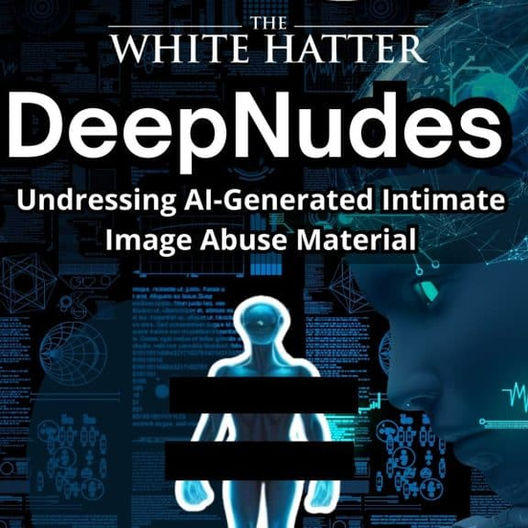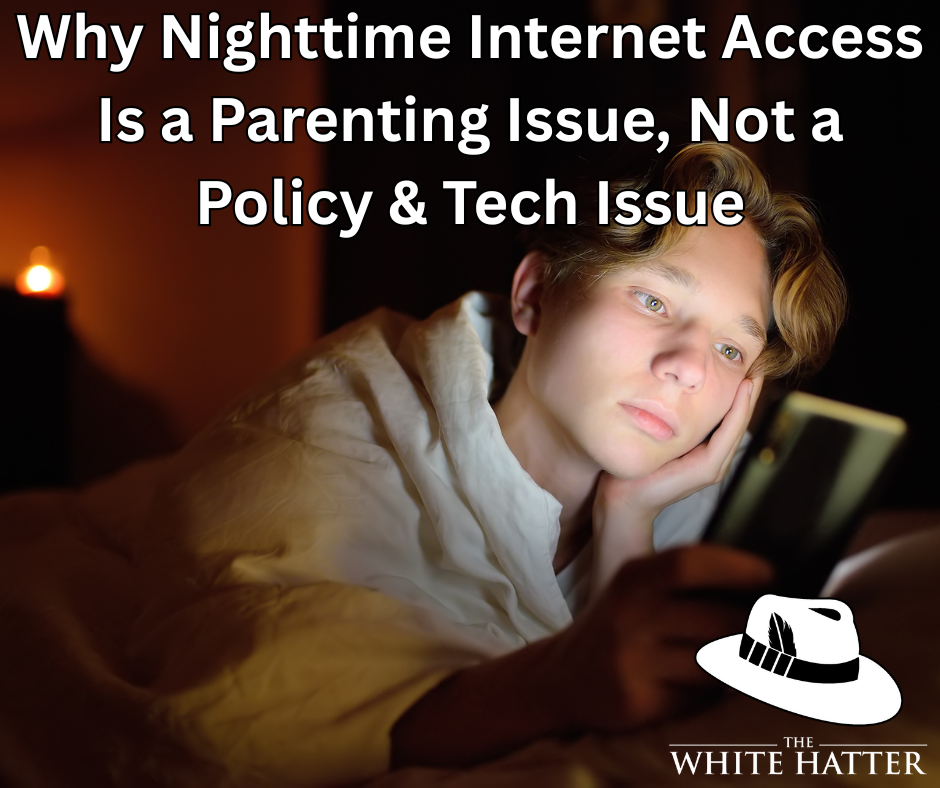The Bad - Youth Tech and Internet Use
- The White Hatter

- Aug 30, 2022
- 8 min read
Updated: May 16

Chapter 2: The Internet Is Not All “Sugar and Spice”
The internet is not all “sugar and spice and everything nice.” Sometimes, there are “snips and snails and puppy-dog tails” that we all need to be aware of. We would be negligent if we didn’t address some of the darker sides of the internet and social media—especially when youth are allowed to participate online unsupervised.
Although we believe that social media, when used in a balanced and healthy way, has more positives than negatives, there are onlife personal challenges precipitated by technology that both parents and teens need to be aware of, including:
Not getting enough sleep—staying on devices into the early hours
Social comparison, especially around body image—on platforms like Instagram or VSCO
Digital peer aggression—cyberbullying
There is good research, which we’ll discuss throughout this web book, showing a strong association (though not necessarily causation) between these challenges and increased anxiety and depression, especially among teen girls.
As Dr. Sonia Livingstone stated:
“The very same characteristics of the internet that make positive contributions possible—immediacy, portability, intimacy, unconstrained reach, and lack of supervision and regulation—have facilitated serious social, intellectual, and mental health risks.”
Teen-Based Less Than Desirable Behaviour
Unfortunately, there is always a small cohort of teens who engage in less-than-desirable online behaviour. Some of the behaviours we have witnessed include:
Seeking validation for inappropriate content
Competing in ego-driven popularity contests
Creating hate pages about peers, teachers, parents, or schools
Venting or throwing shade at others
Showing off for online attention
Engaging in negative online drama
Threatening, harassing, or bullying others
Hacking school district networks
Committing crimes online
While these behaviours come from a small minority, adults often make the mistake of tarring an entire generation with the same brush. The reality is that the majority of this generation is doing super-uber-cool things online, and it’s time we adults acknowledge that.
Sexual Predation & Exploitation
According to the Canadian Centre for Child Protection, there was a 57% increase in reports of adults contacting children aged 8–12 online for sexual purposes via livestream in 2020 (up from 68 in 2018 to 107 in 2019).
We posed the following question to the teens who follow us on social media:
“Have you received an inappropriate sexual message, solicitation, or offer from someone you didn’t know online since the COVID-19 school shutdown?”
296 teens responded:
27% (79) said “Yes”
73% (217) said “No”
Yes, this is anecdotal—but it provides a real-time snapshot of what teens experienced during the pandemic shutdown.
We will be exploring the topic of onlife sexual predation later in this e-book.
Parent Tip
Although any youth can be targeted for online sexual exploitation, we find that those under age 13 are at highest risk. Wherever youth spend time online, there will be those who prey on their innocence—regardless of the app or platform. A U.S. colleague of ours, who teaches from a faith-based perspective, once told us that there are just as many youth being targeted in the Bible app for kids as there are on other mainstream apps.
As we often say: It’s not the app—it’s how the youth use it.
Hate Crime, Misogyny, Xenophobia, and White Supremacy (IMVE Groups)
In March 2021, we conducted an anecdotal survey of our Instagram teen followers. We asked:
“Have you seen racist or hate-based speech in your social media feeds?”
66% said YES.
In fact, a 2020 study found over 6,600 right-wing extremist social media channels and accounts linked to Canada:📚 Read More
According to Statistics Canada, police-reported hate crimes increased by 37% in 2020.
Unknown to many parents, young, socially ostracized males—including those in middle and high school—are primary recruitment targets for radicalization.
With the right to freedom of speech come those who abuse that right to spread hate in all its ugly forms on platforms popular with youth. These groups often use social media to recruit vulnerable teens and spread extremist ideologies.
Two great resources for understanding and tracking these threats:
🎥 Watch: The Fifth Estate’s report on how IMVE groups use social media to recruit and exploit youth.
Pornography and Hypersexualization
Today’s online pornography is not the Playboy magazines that many of us grew up with—hidden under beds or in nightstands. It’s far more graphic, more aggressive, and more extreme. Some common categories in today’s porn include:
Gagging
Rough anal sex
ATM (ass-to-mouth)
Spitting
Severe choking
A 2018 study by the University of Calgary found that 1 in 5 youth reported unwanted exposure to sexually explicit content. The average age of first exposure is now estimated between 9 and 12.
We will discuss pornography and hypersexualization later in this web book.
Onlife Shaming
With mobile technology—phones, GoPros, smart glasses (like Spectacles 3)—comes the ability to covertly record and share videos and photos. These tools can be weaponized to cause emotional, psychological, social, and even physical harm. Often, this is done for attention, likes, followers, or drama.
Digital empathy and mindfulness are sometimes overlooked—or deliberately ignored.
Social Comparison and Body Image
Toxic online influences can deeply harm self-esteem, especially among young girls.
We need to talk to our kids about this reality. According to Media Smart, 80% of 13–16-year-olds are more likely to buy a product or follow advice from an online influencer:📚 Media Smart for Parents
🎥 Dove Video for Parents and Teens:Watch Here
We speak about this in more detail in Chapter 16 of this webbook.
The Use of “Dark Patterns”
A 2018 article described dark patterns as:
“Deceptive UX/UI interactions designed to mislead or trick users into doing something they don’t want to do.”📚 Read Article
Examples that parents and youth should know about include:
Algorithms that intentionally guide youth into toxic digital rabbit holes.
Design features like TikTok’s infinite scroll or Netflix’s autoplay, designed to keep users online longer and increase data collection.
Prompts that push users to enable GPS tracking, often for location-based advertising (e.g., Snapchat Maps).
Parent Tip
We’re often asked: “Is there a safer search engine for kids under 13?”Yes! Try Kiddle.co—a child-friendly search engine that filters out inappropriate content.
Online Gambling
More parents are contacting us about youth involved in online gambling. This is a growing concern.
AI-Generated Content and Deepfakes
One of the fastest-evolving concerns in the onlife world is the misuse of artificial intelligence to generate realistic fake content. Known as deepfakes, these can involve swapping a person's face into a photo or video, often without their knowledge or consent. Some of the most troubling uses include the non-consensual creation of sexually explicit deepfake images and videos of youth.
A 2024 study published in Technology and Human Values found that 90% of deepfake content online is non-consensual and pornographic, and virtually all of it targets women and girls.
We are rapidly approaching a point where teens’ regular selfies—whether posted on social media or shared with friends—can be scraped, cloned, and manipulated into high-definition, fake pornographic content that looks disturbingly real. This is not science fiction or far-off in the future. It's already happening, and the tech is improving daily.
Parent Tip: Talk to your child about the importance of protecting their personal images and data online. Encourage strong privacy settings and avoid posting high-resolution, front-facing photos unnecessarily. Think twice before sharing any image online—even “harmless” ones. As we often say: Just because you can, doesn’t mean you should.
We explore this more in our section on Artificial Intelligence later in this web book
Sugaring and “Transactional Relationships”
Online platforms, including Instagram, Snapchat, and TikTok, are now home to what some teens refer to as “sugar culture.” This trend involves young people—mostly girls but also some boys—seeking out “sugar daddies” (or “sugar mommies”) in exchange for money, gifts, or material benefits. What often starts as what they perceive to be an “arrangement” quickly veers into exploitation and abuse.
The line between consent and coercion is blurred when teens, especially under 18, are financially incentivized to share explicit photos or meet in person.
Key Point for Parents: Transaction doesn’t equal consent. Under Canadian law, it is illegal for an adult to solicit sexual services from a minor. Even if a youth agrees to it, the law recognizes that power imbalance and criminalizes the adult’s behavior—not the teen’s.
We explore this more in our section on OnlyFans and Digital Sugaring Economies in later in this web book
Self-Harm and Suicidal Ideation Communities
Another darker corner of the onlife world includes online forums and hashtags promoting or glamorizing self-harm and suicidal ideation. While some online spaces offer genuine peer support and mental health advocacy, others descend into what researchers call “echo chambers of despair.”
Platforms like Tumblr, Reddit, and even TikTok have hosted pro-anorexia (“pro-ana”) and self-harm content disguised as support.
A 2021 study in JAMA Pediatrics found a significant rise in ER visits for self-harm among adolescent girls, which researchers partially attributed to increased exposure to these kinds of communities during the COVID-19 lockdown.
Parent Tip: Keep communication lines open. Ask your child what content they follow and who influences them. Reassure them that they can talk to you—even about hard stuff—without fear of judgment or punishment. Consider using parental control tools that can alert you to self-harm-related searches or content.
Sextortion and Financial Blackmail
Sextortion isn’t always about shame—sometimes, it’s about money. Increasingly, youth are being blackmailed not by older predators but by organized crime rings who use fake accounts to pose as teens.
Here’s how it typically works:
A teen is approached by someone they think is their age.
They flirt and exchange sexual images or videos.
Suddenly, the blackmailer reveals themselves, demanding money or threatening to share the content with friends, family, or on social media.
Many teens panic and pay, which only encourages further extortion.
A 2023 FBI alert reported that over a dozen suicides of boys aged 13–17 in North America were directly linked to sextortion scams. The Canadian Centre for Child Protection echoed this concern in its 2023 report.
We explore this more in our section on sextortion later in this web book
Mental Health Impacts of “Always On” Culture
In today’s hyperconnected world, many teens feel they can never truly disconnect. Whether it's group chats that buzz 24/7, fear of missing out (FOMO), or the pressure to respond instantly, the constant digital noise can wear down mental resilience.
Signs your teen may be affected:
Irritability or mood swings tied to device use
Insomnia or late-night scrolling
Anxiety when disconnected
Obsession with likes, followers, or views
According to a 2023 Common Sense Media report, 53% of teens said social media makes them feel worse about their body image, while 45% said they feel “addicted” to their devices.
Parent Tip: Don’t just take away the phone—create meaningful alternatives. Consider implementing a family-wide tech-free time each evening, like “Device-Free Dinners” or a “Sunday Unplug.”
Final Thought
Yes, the internet is full of opportunity. Yes, it is a powerful tool for learning, connection, and creativity. But it is also filled with real dangers—especially for youth navigating it without a map or a guide.
We owe it to our children not to fear-monger, but also not to sugarcoat the truth.
As educators, parents, and mentors, our job is not to scare kids away from the onlife world—but to equip them to walk through it wisely.
Coming Up: In the next chapter, we’ll explore what digital resilience looks like in action—and how parents can help cultivate it.














